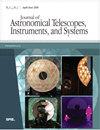预测的力量:为斜面波前传感中的预测控制建立时空高斯过程模型
IF 3.1
3区 工程技术
Q2 ENGINEERING, AEROSPACE
Journal of Astronomical Telescopes Instruments and Systems
Pub Date : 2024-07-01
DOI:10.1117/1.jatis.10.3.039001
引用次数: 0
摘要
时延误差是自适应光学(AO)系统中的一个重要误差源。它产生于感测波前和应用校正之间的延迟。预测控制算法可减少时延误差,显著提高性能,尤其是在高对比度成像方面。然而,预测控制器的性能取决于波前传感器(WFS)类型、测量噪声水平、AO 系统的几何形状和大气条件等因素。我们通过时空高斯过程模型研究了不同成像条件下的预测极限。根据 WFS 数据的固定时间序列和我们对大气条件的了解,该方法提供了最小二乘意义上的最优预测重构器。我们证明了在预测性 AO 控制中,知识就是力量。利用基于夏克-哈特曼传感器的极端定向仪,与非预测方法相比,对风和大气剖面的完美了解以及精确的冻结流演变可将残余波前相位差降低 3.5 倍。如果剖面或演变模型存在不确定性,则收益会更小。不过,假设只有有效风速(没有风向),方差还是减少了 2.3 倍。我们还研究了预测滤波器的数据价值,计算了不同情况下的实验效用,以回答预测滤波器应考虑多少个过去的遥测帧,以及使用最新数据是否总是最有利等问题。我们的研究表明,在所考虑的各种情况下,更多的数据可以持续提高预测精度。此外,我们还证明,考虑到对过去帧数的计算限制,我们可以使用 n 个过去帧数的优化选择,这比使用 n 个最新连续帧数据的均方根提高了 10%-15%。本文章由计算机程序翻译,如有差异,请以英文原文为准。
Power of prediction: spatiotemporal Gaussian process modeling for predictive control in slope-based wavefront sensing
Time delay error is a significant error source in adaptive optics (AO) systems. It arises from the latency between sensing the wavefront and applying the correction. Predictive control algorithms reduce the time delay error, providing significant performance gains, especially for high-contrast imaging. However, the predictive controller’s performance depends on factors such as the wavefront sensor (WFS) type, the measurement noise level, the AO system’s geometry, and the atmospheric conditions. We study the limits of prediction under different imaging conditions through spatiotemporal Gaussian process models. The method provides a predictive reconstructor that is optimal in the least-squares sense, conditioned on the fixed times series of WFS data and our knowledge of the atmospheric conditions. We demonstrate that knowledge is power in predictive AO control. With a Shack–Hartmann sensor-based extreme AO instrument, perfect knowledge of the wind and atmospheric profile and exact frozen flow evolution lead to a reduction of the residual wavefront phase variance up to a factor of 3.5 compared with a non-predictive approach. If there is uncertainty in the profile or evolution models, the gain is more modest. Still, assuming that only effective wind speed is available (without direction) led to reductions in variance by a factor of ∼2.3. We also study the value of data for predictive filters by computing the experimental utility for different scenarios to answer questions such as how many past telemetry frames should the prediction filter consider and whether is it always most advantageous to use the most recent data. We show that within the scenarios considered, more data provide a consistent increase in prediction accuracy. Furthermore, we demonstrate that given a computational limitation on how many past frames, we can use an optimized selection of n past frames, which leads to a 10% to 15% additional improvement in root mean square over using the n latest consecutive frames of data.
求助全文
通过发布文献求助,成功后即可免费获取论文全文。
去求助
来源期刊

Journal of Astronomical Telescopes Instruments and Systems
Engineering-Mechanical Engineering
CiteScore
4.40
自引率
13.00%
发文量
119
期刊介绍:
The Journal of Astronomical Telescopes, Instruments, and Systems publishes peer-reviewed papers reporting on original research in the development, testing, and application of telescopes, instrumentation, techniques, and systems for ground- and space-based astronomy.
 求助内容:
求助内容: 应助结果提醒方式:
应助结果提醒方式:


